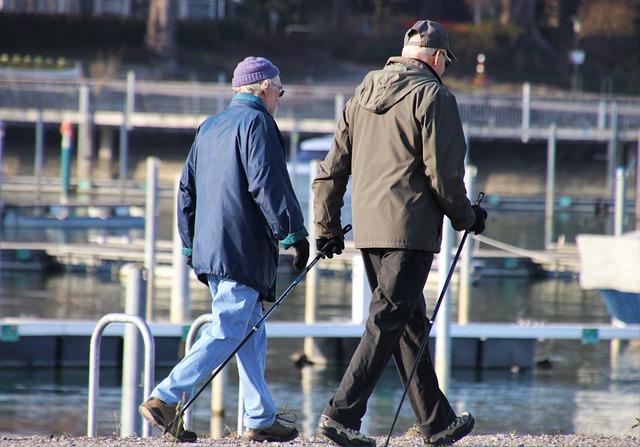Are you a senior who loves the great outdoors and has a passion for hiking? Or maybe you’re new to hiking but eager to explore the beauty of nature at your own pace. Well, you’ve come to the right place! In this comprehensive guide, I’ll dive into the world of training for hiking specifically tailored for seniors.
Hiking isn’t just a fantastic way to soak in the natural wonders around us; it also offers incredible physical and mental health benefits. But before you hit the trails, it’s important to ensure that you’re physically and mentally prepared for the adventure ahead.
In this guide, I’ll share practical tips and insights based on my own experiences and the knowledge I’ve gained along the way. From assessing your fitness level to setting realistic goals, developing a training plan, choosing the right gear, and prioritizing safety, I’ll cover it all. So, let’s get started and discover how you can enjoy the wonders of hiking while staying fit, active, and healthy. It’s time to explore nature’s playground with a spring in your step and a smile on your face.
Assessing Your Fitness Level
Before you hit the trails, it’s crucial to assess your current fitness level. Taking this step allows you to understand your strengths, weaknesses, and potential limitations. Here’s how you can evaluate your fitness level effectively:
- Consultation with a Healthcare Professional: First and foremost, it’s essential to consult with a healthcare professional before starting any new exercise regimen, especially if you have any pre-existing health conditions or concerns. They can provide valuable insights, conduct relevant tests, and offer personalized advice based on your unique circumstances. So, schedule an appointment with your doctor and discuss your plans to ensure you’re on the right track.
- Self-Assessment: In addition to consulting a healthcare professional, a self-assessment can help you gauge your fitness level and capabilities. Consider the following factors:
- Endurance: How long can you engage in moderate physical activity, such as walking or swimming, without feeling overly fatigued? Can you sustain your energy levels for an extended period?
- Strength: Evaluate your strength by assessing your ability to perform functional movements, such as standing up from a seated position or climbing a flight of stairs without difficulty. Do you have the necessary strength in your muscles to support hiking?
- Balance and Stability: Balance is crucial for navigating uneven terrain during hikes. Assess your balance by attempting simple exercises like standing on one leg for a short duration or walking heel-to-toe in a straight line. Take note of any balance-related challenges you may encounter.
- Flexibility: Hiking involves a wide range of movements, so flexibility plays a significant role in preventing injuries. Perform simple stretches and pay attention to areas that feel tight or restricted. This will help identify areas where you may need to improve flexibility.
Remember, this is not a competition but a personal journey towards enhancing your well-being and enjoying the outdoors. Once you’ve assessed your fitness level, it’s time to set realistic goals that align with your abilities and interests.
Setting Realistic Goals
Now that you have assessed your fitness level, it’s time to set realistic goals that align with your abilities and interests. Setting achievable targets ensures that you progress at a pace that is comfortable and enjoyable for you. Here’s how you can establish your hiking goals:
- Start Slow and Gradually Increase Intensity: When it comes to hiking, it’s important to start slow and gradually increase the intensity of your hikes over time. Begin with shorter, easier trails that match your current fitness level. This allows your body to adapt to the physical demands of hiking without putting excessive strain on your muscles and joints.
As you gain confidence and build endurance, gradually increase the difficulty and duration of your hikes. Set milestones for yourself, such as conquering a longer trail or tackling more challenging terrains. Remember, hiking is a journey, and it’s perfectly fine to take it one step at a time.
- Tailor Goals to Your Fitness Level and Interests: Your hiking goals should be tailored to your fitness level and personal interests. Consider distance, elevation gain, and the terrain you feel comfortable tackling. Are you drawn to scenic mountain trails or serene forest paths? Take your preferences into account when planning your hiking goals.
Additionally, be mindful of any physical limitations you may have identified during your self-assessment. Adjust your goals accordingly to ensure they are realistic and attainable for your specific circumstances. It’s better to set achievable goals and experience the joy of reaching them than to overexert yourself and risk injury or burnout.
Hiking is a wonderful opportunity to connect with nature, challenge yourself, and enjoy the journey. Setting realistic goals that suit your fitness level and interests ensures a positive and rewarding hiking experience.
Now that you have your goals in sight, let’s move on to the next step: Developing a Training Plan.
Developing a Training Plan
To prepare your body for the exhilarating adventures of hiking, it’s essential to develop a training plan that focuses on improving your cardiovascular endurance, strength, balance, and flexibility. Let’s dive into the key elements of a comprehensive training plan:
1. Cardiovascular Exercises
Cardiovascular exercises are crucial for building endurance and stamina, which are essential for longer hikes. Engage in activities that elevate your heart rate and increase your breathing rate. Here are some great options for seniors:
- Walking: Walking is a low-impact exercise that can be easily incorporated into your daily routine. Start with shorter walks and gradually increase the duration and intensity.
- Swimming: Swimming is gentle on the joints and provides a full-body workout. Consider joining water aerobics classes or swimming laps to improve cardiovascular fitness.
- Cycling: Cycling is a great way to build leg strength and cardiovascular endurance. Whether it’s on a stationary bike or exploring scenic bike trails, it’s an enjoyable way to train for hiking.
2. Strength and Balance Training
Building strength and improving balance are crucial for navigating uneven terrains and maintaining stability during hikes. Include these exercises in your training plan:
- Squats: Squats strengthen your lower body, including your quads, glutes, and hamstrings. Start with bodyweight squats and progress to using resistance bands or weights.
- Lunges: Lunges work your leg muscles and improve balance. Perform forward, backward, and side lunges to target different muscle groups.
- Calf Raises: Strengthen your calves by performing calf raises. Stand on the edge of a step or curb, rise up onto your toes, and slowly lower down.
- Balance Exercises: Include exercises like standing on one leg, heel-to-toe walk, or yoga poses like Tree Pose to enhance balance and stability.
3. Flexibility and Stretching
Flexibility exercises help improve your range of motion and prevent muscle stiffness or injuries. Prioritize stretching after each workout and on rest days. Focus on stretching the major muscle groups used during hiking, such as your calves, hamstrings, hips, and shoulders.
- Perform dynamic stretches, like leg swings and arm circles, before your workout to warm up the muscles.
- Follow up with static stretches, holding each stretch for 15-30 seconds without bouncing or causing pain.
Remember to listen to your body and start with exercises that suit your current fitness level. Gradually increase the intensity and duration as your strength and endurance improve.
In the next section, I’ll explore the essential gear and equipment you’ll need to ensure a comfortable and safe hiking experience.
Gear and Equipment
Having the right gear and equipment is crucial for a comfortable and safe hiking experience. As a senior hiker, here are some essentials to consider when it comes to gear selection:
1. Proper Footwear
Investing in a pair of high-quality hiking shoes or boots is essential. Look for footwear that offers excellent arch support, cushioning, and traction. Opt for a style that provides ankle support, especially if you’re planning on tackling more challenging terrains. Take the time to try on different pairs and ensure a proper fit. Remember, comfort is key to prevent blisters and foot fatigue.
Before hitting the trails, break in your new footwear by wearing them on shorter walks to ensure they conform to your feet and minimize the risk of discomfort or blisters.
2. Clothing and Layers
Dress appropriately for the weather and consider layering your clothing to regulate body temperature during hikes. Here’s what to keep in mind:
- Moisture-Wicking Fabrics: Choose clothing made from moisture-wicking materials that help keep you dry and comfortable by drawing sweat away from your body.
- Lightweight and Breathable Layers: Dress in lightweight layers that can be easily added or removed to adapt to changing temperatures.
- Protect Yourself from the Elements: Pack a hat to shield your face from the sun, sunglasses to protect your eyes, and apply sunscreen to exposed skin. Don’t forget insect repellent to ward off bugs during your hikes.
3. Hiking Poles and Accessories
Consider using hiking poles, especially if you have concerns about balance or stability. Hiking poles provide extra support, reduce strain on your joints, and can help alleviate pressure on your knees during descents. Additionally, here are a few more accessories to consider:
- Backpack: Invest in a comfortable and lightweight backpack with proper back support. It should have enough room to carry essentials like water, snacks, extra clothing layers, a first aid kit, navigation tools, and emergency supplies.
- Trekking Poles: Trekking poles provide stability and can reduce stress on your knees and hips. They can be particularly helpful when navigating steep or uneven terrain.
- Navigation Tools: Carry a map, compass, or GPS device to ensure you stay on the right track and navigate your hikes effectively.
Gear selection should be based on your specific needs, comfort, and the terrain you’ll be hiking. Don’t hesitate to seek advice from knowledgeable outdoor retailers who can help you find the right gear for your hiking adventures.
Next, I’ll explore important safety considerations to keep in mind while hiking as a senior. Safety should always be a priority, so let’s dive in and ensure your hikes are enjoyable and secure!
Safety Considerations
When it comes to hiking, safety should always be a top priority, regardless of age. As a senior hiker, it’s important to take certain precautions to ensure a safe and enjoyable hiking experience. Here are 7 key safety considerations to keep in mind:
- Hydration and Nutrition: Staying hydrated and properly nourished during hikes is vital, especially for seniors. Carry an adequate supply of water and hydrate regularly, even if you don’t feel thirsty. Pack nutritious snacks like trail mix, energy bars, or fresh fruits to maintain your energy levels throughout the hike.
- Hiking with a Companion: Consider hiking with a companion or joining a hiking group, especially for longer or more challenging trails. Hiking with others provides added safety and support, as well as the opportunity for socializing and sharing the experience. If you prefer solo hikes, inform someone about your plans, including the trail you’ll be hiking and your estimated return time.
- Trail Research and Planning: Before hitting the trails, research and plan your hikes thoroughly. Familiarize yourself with the trail difficulty, length, elevation gain, and any potential hazards or closures. Utilize guidebooks, hiking websites, or smartphone apps to gather reliable trail information. Let someone know your intended route and estimated return time.
- Warm-up and Stretching: Prior to starting your hike, warm up your muscles with light exercises like walking or gentle stretching. This helps prepare your body for the physical demands of the trail and reduces the risk of injuries. Focus on stretching the major muscle groups used during hiking, such as the calves, quads, hamstrings, and shoulders.
- Weather Awareness: Keep an eye on the weather forecast before heading out on your hike. Dress appropriately for the conditions and be prepared for changes in weather. In case of inclement weather, such as thunderstorms or heavy rainfall, it’s advisable to postpone or modify your hiking plans.
- Emergency Preparedness: Carry a well-stocked first aid kit with essentials like bandages, adhesive tape, antiseptic wipes, and any necessary personal medications. Familiarize yourself with basic first aid procedures. Additionally, bring along emergency supplies like a whistle, flashlight, extra food, and a space blanket in case of unforeseen circumstances or delays.
- Listen to Your Body: Pay attention to your body during hikes. Take breaks when needed, pace yourself, and don’t hesitate to turn back or modify your plans if you’re feeling fatigued, experiencing pain, or encountering challenging conditions. It’s essential to respect your limits and prioritize your safety and well-being.
Preparing for the Hike
Before you hit the trails, it’s important to make some preparations to ensure a smooth and enjoyable hiking experience. Here are some key steps to take when preparing for your hike:
- Trail Research and Planning: Take the time to research your chosen trail thoroughly. Look for trail maps, descriptions, and reviews to familiarize yourself with its difficulty level, length, elevation gain, and any notable features. Check for any trail closures or restrictions, and be aware of any permits or fees required.
- Warm-up and Stretching: Before you begin your hike, warm up your muscles with a few minutes of light exercises, such as brisk walking or gentle stretching. This helps to increase blood flow and prepare your body for the physical demands of the trail. Focus on stretching the major muscle groups used during hiking, including your calves, quads, hamstrings, and shoulders.
Packing Essentials:
Make a checklist of essential items to pack for your hike. These may include:
- Water and Snacks: Carry an ample supply of water to stay hydrated throughout your hike. Pack nutritious snacks like trail mix, energy bars, or fresh fruits to fuel your body.
- Proper Clothing: Dress in layers to accommodate changing weather conditions. Wear moisture-wicking and breathable fabrics to keep you comfortable. Don’t forget to wear a hat, sunglasses, and apply sunscreen to protect yourself from the sun’s rays.
- Navigation Tools: Bring a map and compass or a GPS device to help you navigate the trail accurately. Familiarize yourself with how to use these tools before your hike.
- First Aid Kit: Pack a well-stocked first aid kit containing essentials like bandages, antiseptic wipes, pain relievers, and any necessary personal medications.
- Communication Devices: Carry a fully charged cell phone or a two-way radio for emergency communication. Ensure you have a signal or inform someone about areas with limited or no cell phone reception.
- Extra Clothing and Rain Gear: Pack an extra layer of clothing in case of unexpected weather changes or temperature drops. Include a lightweight rain jacket or poncho to stay dry during rainy conditions.
Leave No Trace: Respect the environment and practice Leave No Trace principles. Carry out all your trash, dispose of waste properly, and avoid damaging vegetation or wildlife. Leave the trail as you found it, preserving its beauty for future hikers to enjoy.
Inform Others: Let someone reliable know about your hiking plans, including your intended trail, estimated start and end times, and any alternative plans you may have. This way, they can check on you if needed or alert authorities in case of an emergency.
Conclusion
Congratulations! You’ve reached the end of this comprehensive guide on training for hiking for seniors. Now armed with the knowledge and strategies shared, you’re ready to embark on unforgettable adventures in the great outdoors.
Remember, hiking is not just about physical exertion, but also about the serenity of nature, the camaraderie of fellow hikers, and the sense of accomplishment as you conquer new trails. Take each step with confidence, embracing the beauty around you and cherishing the moments of tranquility.
As a senior hiker, you have the power to rewrite the narrative of aging by staying active, challenging yourself, and experiencing the wonders of nature. So, lace up your boots, breathe in the fresh air, and let the trails lead you to new heights.
May your journeys be filled with breathtaking views, connections with nature, and a renewed sense of vitality. Embrace the joy of hiking, and let it be a catalyst for a vibrant and fulfilling life. Happy hiking trip!
You might like to read this article next: Is Ziplining Safe For Seniors?










